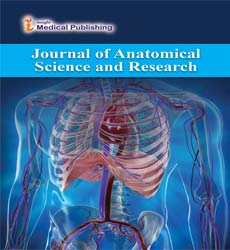A Preliminary Overview of Reproductive Physiology
Michael Nandi*
Department of Reproductive Physiology, Bayero University, Kano, Nigeria
- *Corresponding Author:
- Michael Nandi
Department of Reproductive Physiology
Bayero University
Kano, Nigeria
Tel: 07032867476
E-mail: enandi5@gmail. com
Received Date: February 12, 2021 Accepted Date: February 26, 2021 Published Date: March 5, 2021
Citation: Nandi M (2021) A Preliminary Overview of Reproductive Physiology. J Anat Sci Res Vol. 4 No.1:3.
About the Study
The male and female gonads and the genitalia develop from common precursors in the first weeks of embryonic life, but the final stages of sexual differentiation are not completed until puberty. Human reproduction and sexuality are unique in the way they are defined by recreation and pleasure in addition to procreation; physiological and psychological satisfaction. In sexually mature males, millions of gametes (spermatozoa) are continually produced by the testes, whereas in females, fertility is cyclical and yields a single gamete (oocyte) approximately once per month. If intercourse occurs at the appropriate time, ejaculation of sperm into the female reproductive tract enables the fertilization of the oocyte by a single sperm. Implantation of the developing embryo occurs in the uterus, and is rapidly followed by development of the placenta. The normal gestation period of forty weeks ends with labor and parturition (childbirth). The final differentiation of the female breast occurs during pregnancy to allow lactation and breast-feeding. The complex events in male and female reproductive physiology are orchestrated by the pituitary, the gonadal, and (during pregnancy) the placental hormones.
Sexual Differentiation
Sexual differentiation refers to the transformation of the undifferentiated gonads of the early embryo into functional male and female reproductive systems. Anatomic differentiation occurs in utero, but the final maturation that produces fully functional reproductive organs is not completed until puberty.
Reproductive Embryology
The process that determines whether male or female reproductive organs develop depends on the complement of sex chromosomes present; female gametes (oocytes) all have the same 22X chromosomal makeup, whereas male gametes (spermatozoa) are either 22X or 22Y. The chromosomal sex of the fetus is determined at fertilization when the male and female gametes combine; XX is female and XY is male. The default phenotypic sex is female if the fetus does not have a Y chromosome. The presence of a Y chromosome directs the undifferentiated gonad to become a testis rather than an ovary. A single gene (SRY), located in the sexdetermining region of the Y chromosome, is required for male sexual differentiation. Before sexual differentiation begins, the fetus has developed two parallel duct systems located near the undifferentiated gonads: the mesonephric (wolffian) duct and the paramesonephric (müllerian) duct. By week of 10 gestations, the fetal gonads can be distinguished as either testes or ovaries.
Gametogenesis
Testosterone
It belongs to a group of steroid hormones called ‘androgens’. It is synthesized in the testes. Other androgens are produced by the adrenal cortex. eg: DHEA (Dehydroepiandrosterone). Estradiol and Progesterone: One of three major ‘estrogens’. It is the predominant estrogen in the plasma. The two other major estrogens are estrone and estriol, progesterone is a major secretary product of the ovary in specific times of the menstrual cycle as well as from the placenta during pregnancy.
Testosterone
It belongs to a group of steroid hormones called ‘androgens’. It is synthesized in the testes. Other androgens are produced by the adrenal cortex. eg: DHEA (Dehydroepiandrosterone). Estradiol and Progesterone: One of three major ‘estrogens’. It is the predominant estrogen in the plasma. The two other major estrogens are estrone and estriol, progesterone is a major secretary product of the ovary in specific times of the menstrual cycle as well as from the placenta during pregnancy.
Control of reproductive functions
For both male and female reproduction, the reproductive function is controlled by a chain of hormones. the first hormone in the chain is Gonadotropin-Releasing Hormone (GnRH), released by the hypothalamus to stimulate the release of pituitary gonadotropins Follicle-Stimulating Hormone (FSH) and luteinizing hormone (LH) from the anterior pituitary gland. In both males and females these two hormones act to promote gametogenesis and androgen/estrogen secretion. In addition the gonadal steroids exert feedback effects on the secretion of GnRH, FSH and LH.
General principles of gametogenesis
It is the process of formation of gametes from the germ cells in the testes and ovaries. The first stage is the division of the primordial (immature) germ cells by mitosis. The DNA of each nucleated cell with the exception of gametes contains 46 chromosomes. In this first stage, (mitosis) the 46 chromosomes of the dividing cell are replicated. The end results are two daughter cells containing the full 46 chromosomes identical to those of the original cell.
Open Access Journals
- Aquaculture & Veterinary Science
- Chemistry & Chemical Sciences
- Clinical Sciences
- Engineering
- General Science
- Genetics & Molecular Biology
- Health Care & Nursing
- Immunology & Microbiology
- Materials Science
- Mathematics & Physics
- Medical Sciences
- Neurology & Psychiatry
- Oncology & Cancer Science
- Pharmaceutical Sciences
